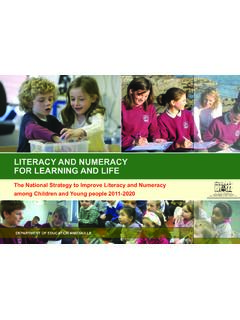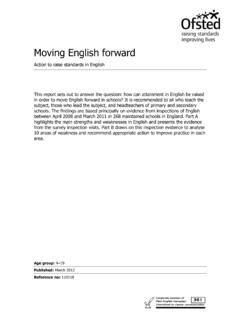Transcription of The Effect of Cross-curricular Instruction on Reading ... - ed
1 Universal Journal of Educational Research 4(8): 1797-1801, 2016 DOI: The Effect of Cross-curricular Instruction on Reading Comprehension Yasin Aslan Department of Foreign Languages, Faculty of Education, Sinop University, Turkey Copyright 2016 by authors, all rights reserved. Authors agree that this article remains permanently open access under the terms of the Creative Commons Attribution License international License. Abstract Cross-curricular objectives serve as a kind of Teachers who use Cross-curricular themes create active safety net' for core objectives. Firstly, Cross-curricular readers by engaging students in authentic literacy tasks that objectives refer to competencies that do not pertain to the emerge naturally from interesting and worthwhile topics content of one or more subjects, but that can be taught, and ideas.
2 Authentic tasks focus on student choice and practised and applied in it, such as learning to learn and ownership; extend beyond the classroom walls; involve a social skills. Secondly, certain Cross-curricular final variety of Reading and writing opportunities; promote objectives must also be regarded as a complement to the discussion and collaboration; and build upon students'. subject final objectives. They render it possible to make the interests, abilities, background, and language development subjects more coherent and interconnected. Several studies (Hiebert, [2]; Paris et al., [3]). Cross-curricular themes show that without enough background familiarity with L2 integrate a variety of content areas, such as science, social cultural knowledge, readers have great difficulty in studies, art, and so forth.
3 Good readers connect and utilize understanding the meaning of texts. This study describes ideas and information from a variety of previous life and strategies of Cross-curricular Reading Instruction , discusses literacy experiences (Anderson et al, [4]). Sustained Reading its benefits, advantages and challenges for teachers or other of interesting texts improves Reading comprehension and interested groups who want to encourage their students to enhances enjoyment (Fielding & Pearson, [5]; Reutzel &. explore significant subjects, problems, and questions by Cooter, [6]). Over time, the Effect is that comprehension providing them with a wide range of Reading opportunities. It improves as students read more (Hartman & Hartman, [7]).
4 Presents suggestions for teaching themes that focus on what Thus, to increase understanding, students should gain students know, because such themes increase confidence, experience in Reading a variety of texts, including narrative improve Reading skills, expand concepts and background, and expository literature, as well as "real world" materials and foster positive attitudes about Reading . such as brochures, magazine articles, maps, and informational signs. Because our lives require us to Keywords Reading , Cross-curricular Teaching, Culture, integrate what we have learned in an interdisciplinary Background Knowledge manner, teaching children through merged disciplines better prepares them for applying new knowledge and experience.
5 In addition, when students view their learning as having personal relevance, they put more effort into their 1. Introduction schoolwork and achievement (Willis, [8]). Using students' backgrounds, knowledge and experiences Reading is one of the most important skills for daily life. to inform learning in the classroom and during Reading People usually read because they want to get information Instruction is of great significance. Schools and teachers about various topics. Reading comprehension is a dynamic should try to build a bridge between students' home and mental activity in which the reader interacts with the school lives. Ladson, [9]) defines culturally-compatible passage to extract meaning. Unlike previous beliefs that teaching as a kind of teaching that is designed not only to fit Reading is a passive skill, it is now regarded as a process in the school culture to the students' culture but also to use which the reader picks out available information and student culture as the basis for helping students understand cross-cultural familiarity only enough to understand the themselves and others, structure social interactions, and meaning of the text.
6 In a text, words are combined in such a conceptualize knowledge. way that their relative position andpatterns contribute to It is necessary for teachers and schools to not only their collective meaning (Farhady, [1]). provide all students with the tools to achieve academic 1798 The Effect of Cross-curricular Instruction on Reading Comprehension proficiency, but to also make each and every student feel varied purposes. comfortable regardless of their ethnic, racial and inguistic Make choices, interact, collaborate, and background. Also, culturally talented teachers are adept at cooperate. using students' cultures as a vehicle for learning and Apply what they learn in meaningful and "real provide students with a curriculum based on their prior world" contexts.
7 Knowledge. A key aspect of this requires actively Informally assess their understanding and encouraging students to maintain their cultural integrity in application of what they are learning. the classroom. For instance, students who speak second Participate and learn, regardless of ability, level languages, or who do not have standard' English for their of language development, or background. primary discourse, should not be discouraged from using Learn effectively in self-contained, multi-age, or their primary or home language in the classroom. departmental classrooms. Culturally relevant Instruction help students develop a broader sociopolitical consciousness through engaging in the world and with others critically.
8 Students are 3. The Purpose of the Study encouraged to interrogate the cultural norms, values, mores, and institutions that produce and maintain social This study describes strategies of Cross-curricular Reading iniquities. This concept is closely related to that of critical Instruction , discusses its benefits, advantages and literacy whereby learners adopt critical perspectives challenges for teachers or other interested groups who want toward texts such as songs, poems, novels, conversations, to encourage their students to explore significant subjects, pictures and movies. In culturally relevant Reading problems, and questions by providing them with a wide Instruction , texts are used to stimulate dialogue as regards range of Reading opportunities.
9 After looking over the prominent social subjects and institutions significant to literature, this study tries to find an answer to the following students' lives, like family, government, equality, social question: justice, racism, poverty etc. What is the Effect of cross-cultural background Teachers should be aware of the fact that students'. knowledge and cultures are shaped by their sociocultural knowledge Instruction on Reading comprehension? and sociolinguistic backgrounds, as well as the socioeconomic and political circumstances in which their Planning and Choosing a Theme lives take shape. Gender, ethnicity, race, language, religion, When planning, it is important to select themes that are social class and generational group must all be taken into not only interesting to students, but are meaningful and account in the classroom and during Reading Instruction .
10 In substantive. A theme on the environment helps students addition, teachers must be able to function effectively understand the importance of preserving and protecting the within multiple cultural contexts. Cultural training' Earth. A theme on sports encourages students to engage in workshops or programs for teachers may be esseantial; sports activities and stay healthy. Themes like these offer however, it is admissible to assume that cultural the opportunity to explore important ideas that challenge competence can best be learned reciprocally alongside students to seek information beyond what they already students in the context of respectful and culturally-sensitive know (Walmsley, [15]). For instance, students may daily interactions in the classroom.













